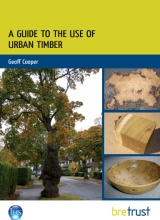A guide to the use of urban timber FB 50
BRE (Building Research Establishment) is an independent, research-based consultancy, testing and training organisation, operating in the built environment and associated industries.
A guide to the use of urban timber (FB 50) was written by Geoff Cooper and published by BRE on 31 July 2012.
Every day across the UK, thousands of tonnes of wood residue are produced through arboricultural work. However, the timber this produces is normally variable and inconsistent, resulting in problems with collection, transportation and selection. As a result, much of it is relegated to the much or firewood bin.
FB 50 is a 64-page illustrated guide to using timber from the UK’s urban timber resource, including street, park and urban woodland trees. It provides guidance on the selection and identification of high-value stems, as well as processing, drying, transport, storage and the logistical problems of dealing with felled material.
The guidance promotes the use of many common and exotic species for high-value solid wood products rather than being processed for firewood, chipped to produce mulch or sent to landfill. It is intended to help local authorities maximise the value of timber produced in towns and cities and to develop the best options for using solid wood produced during normal maintenance.
The contents of the guide are:
- Introduction.
- Material and species availability.
- Assessing stems for timber production.
- Value-added growth feature.
- A sawmill perspective.
- Timber dimensions, measurement and material grading.
- Wood drying.
- Air drying.
- The kiln drying of timber.
- Kiln drying processes.
- Drying schedules.
- Problems associated with wood drying.
- Calculating value.
- Identifying prospective markets.
- Appendix: Species list and wood property information.
- References.
[edit] Related articles on Designing Buildings Wiki
- 11 things you didn't know about wood.
- BRE articles on Designing Buildings Wiki.
- BRE Buzz articles on Designing Buildings Wiki.
- BRE Buzz.
- Building Research Establishment.
- Carpentry.
- Cat's paw figure.
- Definition of tree for planning purposes.
- Delivering sustainable low energy housing with softwood timber frame.
- Dunnage.
- End racking.
- Facts about forestry.
- Forest ownership.
- Forests.
- Physical Properties of Wood.
- Rip sawing.
- Ripple figure.
- Spalting.
- The differences between hardwood and softwood.
- Tiger-stripe figure.
- Timber preservation.
- Timber sticker.
- Timber vs wood.
- Timber.
- Tree preservation order.
- Tree rights.
- Types of timber.
- Urban trees.
- Waney edged.
Featured articles and news
Grenfell Tower Principal Contractor Award notice
Tower repair and maintenance contractor announced as demolition contractor.
Passivhaus social homes benefit from heat pump service
Sixteen new homes designed and built to achieve Passivhaus constructed in Dumfries & Galloway.
CABE Publishes Results of 2025 Building Control Survey
Concern over lack of understanding of how roles have changed since the introduction of the BSA 2022.
British Architectural Sculpture 1851-1951
A rich heritage of decorative and figurative sculpture. Book review.
A programme to tackle the lack of diversity.
Independent Building Control review panel
Five members of the newly established, Grenfell Tower Inquiry recommended, panel appointed.
Welsh Recharging Electrical Skills Charter progresses
ECA progressing on the ‘asks’ of the Recharging Electrical Skills Charter at the Senedd in Wales.
A brief history from 1890s to 2020s.
CIOB and CORBON combine forces
To elevate professional standards in Nigeria’s construction industry.
Amendment to the GB Energy Bill welcomed by ECA
Move prevents nationally-owned energy company from investing in solar panels produced by modern slavery.
Gregor Harvie argues that AI is state-sanctioned theft of IP.
Heat pumps, vehicle chargers and heating appliances must be sold with smart functionality.
Experimental AI housing target help for councils
Experimental AI could help councils meet housing targets by digitising records.
New-style degrees set for reformed ARB accreditation
Following the ARB Tomorrow's Architects competency outcomes for Architects.
BSRIA Occupant Wellbeing survey BOW
Occupant satisfaction and wellbeing tool inc. physical environment, indoor facilities, functionality and accessibility.
Preserving, waterproofing and decorating buildings.
























